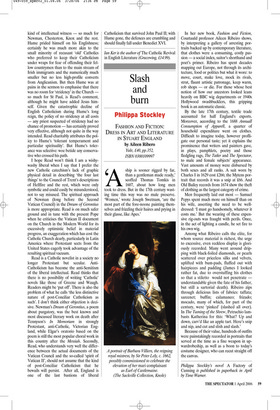Slash and burn
Philippa Stockley
FASHION AND FICTION: DRESS IN ART AND LITERATURE IN STUART ENGLAND by Aileen Ribero Yale, £40, pp.352, ISBN 0300109997 ‘A ship is sooner rigged by far, than a gentleman made ready,’ scoffed Thomas Tomkis in 1607, about how long men took to dress. But in the 17th century wast ing time this way was no male preserve. ‘Women,’ wrote Joseph Swetnam, ‘are the most part of the fore-noone painting them selves and frizzling their haires and prying in their glasse, like Apes.’ A portrait of Barbara Villiers, the reigning royal mistress, by Sir Peter Lely, c. 1662, possibly commissioned to celebrate the elevation of her mari complaisant as Earl of Castlemaine. (The Sackville Collection, Knole) In her new book, Fashion and Fiction, Courtauld professor Aileen Ribeiro shows, by interpreting a gallery of arresting portraits backed up by contemporary literature, that clothes were a consuming, costly passion — a social index, suitor’s shorthand and poet’s primer. Ribeiro has spent decades mapping out Europe, not through its architecture, food or politics but what it wore: to move, court, make love, mock its rivals, strut, flaunt artistic patronage, keep warm, rob shops — or die. For those whose best notion of how our ancestors looked leans heavily on BBC wig departments or 1940s Hollywood swashbucklers, this gripping book is an automatic classic.
By the late 17th century, textile trade accounted for half England’s exports. Moreover, according to the 1688 Annuall Consumption of Apparell, a quarter of household expenditure went on clothes. Difficult to imagine today, however profligate our personal taste; yet it explains the prominence that writers and painters gave, in plays, pamphlets, poetry and those fledgling rags, The Tatler and The Spectator, to male and female subjects’ appearance. Vast amounts of money were disbursed by both sexes and all ranks. A suit worn by Charles I in 1629 cost £266; the Mytens portrait that records it was a snip at £66. And Old Bailey records from 1674 show the theft of clothing as the largest category of crime.
Men frequently laid out most — Samuel Pepys spent much more on himself than on his wife, asserting the need to be welldressed: ‘I must go handsomely, whatever it costs me.’ But the wearing of these expensive rig-outs was fraught with perils. Once, in the act of lighting a candle, he set fire to his own wig.
Among what Ribeiro calls the elite, for whom source material is richest, the urge to excessive, even reckless display is gloriously recorded. Many went around dripping with black-foiled diamonds, or pearls scattered over priceless silks and velvets, uplifted with bum-pads, fluffed out with hairpieces and padding (James I looked rather fat, due to overstuffing his clothes so that a stiletto would not penetrate understandable given the fate of his father, but still a sartorial death). Ribeiro zips through delicious lists of fabrics: taffata; sarcenet; buffin; calamanco; frizado; mocado, many of which, for part of the century, were ‘pinked’ (slashed all over). In The Taming of the Shrew, Petruchio lambasts Katherina for this: ‘What? Up and down, carv’d like an apple tart. Here’s snip and nip, and cut and slish and slash.’ Because of their value, hundreds of outfits were painstakingly recorded in portraits that served at the time as a fine weapon in upwardrobeship, as well as a boon to today’s costume designer, who can recut straight off the canvas.


























































































 Previous page
Previous page